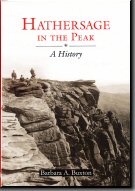Review of ‘Hathersage in The Peak’, by Barbara A. BuxtonThis review is by Julie Bunting, and was published originally in The Peak Advertiser, the Peak District's local free newspaper, on 5th December 2005, and is reproduced with Julie's kind permission.
The Romans knew the Hope Valley as a frontier between restless native tribes, the Danes built a military camp here and the Saxons gave name to Hathersage itself. The boundaries of the parish became surprisingly extensive, once incorporating the now lost village of Derwent, although daily life and land ownership often strayed outside official limits. Barbara begins her story in the distant past when the present surrounding moorlands were covered by forests. She takes the reader through a huge range of topics from archaeology to manorial lordships, civil wars to the industrial revolution, the mapping of roads to unprincipled land grabs. Her real-life characters include lords and ladies, village worthies, thieves, rogues and outlaws - the Little John connection being dealt with very neatly. We learn why three lords of the manor are buried in east London and how a Tudor king intervened in the case of a kidnapped heiress, an event with far-reaching consequences. Over the years, farms tended to be promoted to halls and halls became manors. Everyday life in Hathersage had its moments too; fisticuffs over a disputed right of way, doubtless noisy scenes of hue and cry, an official ducking, a branding and a hanging. Even the "precarious and ruthless business of millstone working included poaching workmen from other employers." In modern times the village has given refuge to Dunkirk survivors and victims of the Blitz. In hardback with over 100 illustrations. Review by Julie Bunting |
|||
